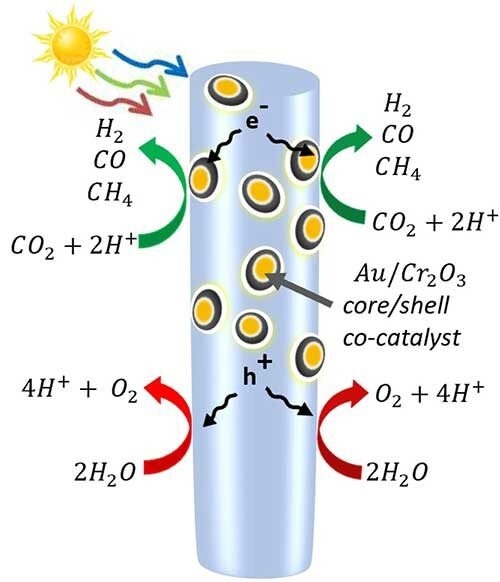An international research team has demonstrated that solar-powered synthesis gas could recycle carbon dioxide into fuels and beneficial chemicals.

A diagram of the semiconductor nanowires made of indium, gallium, and nitrogen—decorated with gold and chromium oxide nanoparticles. When the light hits the nanowire, it frees up electrons and the positively charged “holes” that electrons leave behind. On the nanowire itself, the holes oxidize water into protons (hydrogen) and oxygen. Meanwhile, some electrons are drawn into the metal nanoparticles, where they break apart carbon dioxide. The molecules recombine into the carbon monoxide, hydrogen, and methane molecules that make up syngas. Image Credit: Roksana Rashid, McGill University
If we can generate syngas from carbon dioxide utilizing only solar energy, we can use this as a precursor for methanol and other chemicals and fuels. This will significantly reduce overall CO2 emissions.
Zetian Mi, Professor, Electrical and Computer Engineering, University Of Michigan
Mi headed the study published in the Proceedings of the National Academy of Science.
Syngas, which are primarily composed of hydrogen and carbon monoxide with a trace of methane, is generally extracted from fossil fuels using electricity. To make the process more effective, toxic chemicals are frequently added.
Our new process is pretty simple, but it’s exciting because it’s not toxic, it’s sustainable and it’s very cost-effective.
Roksana Rashid, Study First Author and Doctoral Student, Electrical and Computer Engineering, McGill University
Mi’s group battled with the complexity of dividing carbon dioxide molecules, which are among the most consistent in the universe, to generate a system that utilizes only solar energy. They did this by sprinkling nanoparticles throughout a forest of semiconductor nanowires. These gold-coated chromium oxide nanoparticles attracted and bent carbon dioxide molecules, loosening the bonds between carbon and oxygen.
To free electrons and the positively charged spaces they left behind, referred to as holes, the gallium nitride nanowires used light energy. The holes separate the protons (hydrogen) from the oxygen by splitting water molecules. The electrons then divide the carbon dioxide at the metal catalysts, generating carbon monoxide and drawing in free hydrogen to produce methane. Processes for separating oxygen from other gases are being developed.
“Our technology sheds light on how to build distributed syngas production from the air, water and sunlight,” said Baowen Zhou, co-corresponding author of the study with Mi and a former postdoctoral research fellow in Mi’s lab at McGill University and U-M.
Mi’s team was able to regulate the relative proportions of hydrogen and carbon monoxide produced in the reaction by changing the ratio of gold to chromium oxide in the nanoparticles. This is significant since the ratio of hydrogen to carbon monoxide influences how simple it is to achieve a specific fuel or chemical.
“What is surprising is the synergy between gold and chromium oxide to make the CO2 reduction to syngas efficient and tunable. That was not possible with a single metal catalyst,” Mi said. “This opens up many exciting opportunities that were not previously considered.”
Mi’s scalable tunable syngas setup employs standard industrial manufacturing techniques. While Rashid used distilled water in this test, it is expected that seawater and other electrolyte solutions will also work, and Mi has used them in associated water-splitting experiments.
“The semiconductor we use as the light absorber is based on silicon and gallium nitride, which are the most commonly produced semiconductors, and we use very little material for the gallium nitride. Each nanowire is about one micrometer in thickness,” Mi said.
Mi’s upcoming goal is to improve the device’s effectiveness, which is presently at 0.89%. When 10% of the light energy is transformed into chemical energy, he hopes that the technology, like solar cells, will be established for renewable energy.
The Emission Reduction Alberta ERA, which is based at McGill University in Canada, funded the project. The co-authors are all current or former McGill students. Rashid is a postdoctoral researcher in electrical and computer engineering at the University of Waterloo, Canada. Zhou is a mechanical engineering associate professor at Shanghai Jiao Tong University.
A licensing agreement for intellectual property proposed in this research is being negotiated to bring the technology to market and have a huge impact on the environment. Mi co-founded both companies, NS Nanotech Inc. and NX Fuels Inc. The University of Michigan and Mi own these businesses.
Journal Reference:
Rashid, R. T., et al. (2022) Solar-powered chemistry uses carbon dioxide and water to make feedstock for fuels, chemicals. Proceedings of the National Academy of Science. doi.org/10.1073/pnas.2121174119.